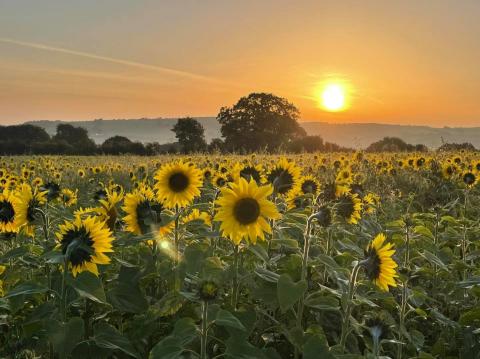Ffrith Farm Project Introduction: Building a farm destination experience around existing resources
Site: Ffrith Farm
Address: Treuddyn, Mold, Flintshire
Technical Officer: Debbie Handley
Project Title: Building a farm destination experience around existing resources
Introduction to project:
Ed Swan has grown up on his family farm, which is a traditional hill farm in the village of Treuddyn, near Mold in north Wales. The Swan family have farmed at Ffrith Farm since 1980, and they produce their own home-reared beef and pork to sell from their farm shop on-site.
The farm has approximately 120 beef cattle: Hereford, Aberdeen Angus, British Blue, Simmental, Charolais, Welsh Black, Limousin and Shorthorn, and over 100 pedigree Welsh pigs, all free-range. They also have egg-laying hens that keep the shop supplied.
Arable crops of wheat, barley, silage, hay, kale and turnips are grown on the farm to feed the livestock. Harvesting takes place from June to October and supplies them with all the feed needed for the next 12 months.
Ffrith Farm Sunflower field 2021
A Farm Trail allows the public around the circumference of the farm, offering amazing views and opportunities to see the animals grazing in their fields, the farmers at work, the different types of crops and some incredible wildlife. It is this area of the farm that the project intends to build on, developing the farm destination experience by growing sunflowers and pumpkins, expanding on the opportunities for the public to visit the farm, bringing in additional income, engaging more with the local community and building biodiversity into the day-to-day farm activities.
Pumpkin and flower Pick Your Own enterprises have become extremely popular over the last few years – particularly so since the pandemic, with people keen to undertake outdoor experiences and activities. The enterprises will make use of land around the farm shop, where customers are easily able to view and access the PYOs.
Project Objectives:
The project will consider using existing resources, developing the land adjacent to the shop, and fitting new enterprises in with the labour demands of the farm. Growing sunflowers and pumpkins requires careful management to achieve production and clearance of the crop to meet the short harvest window. However, they can be easily managed alongside current routine farming activities, and in this instance, will require limited operational sales input due to having the shop on-site.
The project will:
- Explore choice of varieties of sunflowers and pumpkins, considering colour and size required for a PYO setting.
- Develop areas around the shop for the pumpkin and sunflower Pick Your Own.
- Focus on weed control and providing the correct nutrient balance for the crops, recording any disease issues.
- Consider how to build additional biodiversity into the existing farming activities, for example, encouraging more wildlife and pollinators, using fewer chemicals.
- Engage the public and local community through the use of social media and using existing networks/connections, such as schools, community groups and public-facing groups.
- Provide educational material to help inform the public about mainstream farming and the benefits of animals to soil fertility and holistic farm management.
Key Performance Indicators:
To provide information and knowledge gained from:
- Financial viability of all enterprises – farm trail, pumpkins, sunflowers
- Time/labour and cost inputs - number of hours worked, how it impacts and/or complements existing farming activities, cost of plants, seeds, chemicals, fertiliser, equipment, etc. against extra income
- Public/community engagement
- Impact of working to support increased biodiversity
Timeline and milestones:
February 2022 - Research suitable pumpkin and sunflower varieties. Measure land area for planting and to work out quantity of seeds needed. Consultancy on soil suitability, what to plant where, growing considerations such as soil testing, weed suppression and nutrient requirements. Order pumpkin plants from a recommended supplier, as discussed with ADAS consultant during visit.
March - Preparing the land. Bed cultivation to start, weather permitting. Take photos of progress and put on social media to build customer interest.
April - Bed cultivation, ploughing and weeding. Rebuilding the hen house. Adding nutrients ahead of planting sunflowers. Plant the sunflowers once the ground is warm enough. Photos and social media.
May - Final preparation of ground for planting. Plant pumpkins out if warm enough at the end of the month, or wait until early June if there’s a risk of frost. Photos and social media.
June - Planting out pumpkins during the last week of May or first week of June, depending on the growth of plants and weather conditions. Consider farm trail paths, signs and content for information boards. Think about social media promotional posts for the sunflowers and the pumpkins – give consideration to booking system and refreshments during the PYO times.
July-August - Monitor weeds, disease and irrigate where required. Remove any weeds as soon as they appear. Social media posts highlighting when the sunflowers will be ready. Start sunflower PYO at the end of August, and keep promoting the pumpkins coming soon.
September - Commence daily social media campaign to encourage interest from the public. Monitor pumpkin crop for mildew, etc. Consider treatment, with consultant advice. Plan parking, signage, toilets and any booking system.
October - Start PYO not too far ahead of Halloween. Consider if any pumpkins need to be pre-picked and moved into the shop for sale.
November - Calculate percentage of crop left post-Halloween. Clear ground for winter and sell/donate any leftover crops or feed to animals.
December - Collate all the information and costings recorded and produce final project review report.

